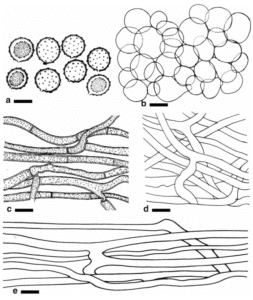Lycoperdon lahorense Yousaf & Khalid, sp. nov.
Index Fungorum number: IF 556119; MycoBank number: MB 556119; Facesoffungi number: FoF 05752; Figs. 70, 71, 72
Etymology: Named after the type locality 'Lahore'.
Holotype: LAH100000148.
Basidiocarps globose to somewhat pyriforme, small to medium, 8–20 mm diam × 9–25 mm in height, off white to pale yellow above when young, pale brown to greyish brown with age, off-white to light yellow at the base; attached to the substratum by white, branched rhizomorphs, encrusted with particles of soil; dehiscence by an apical pore up to 4 mm diam. Peridium double. Exoperidium pale yellowish to greyish brown with age, not persistent, fragile, peeling off in the form of patches, patches with pale brown to dark brown warts, sub-flocculate, sometimes entire exoperidium in the form of minute, prominent warts, these more above, and lesser below, encrusted with debris. Endoperidium papery, greyish brown to grey towards apical portion when mature, off-white to pale yellow downwards, entirely exposed in mature specimens. Gleba olivaceous to brown, cottony. Diaphragm distinct. Subgleba pale yellow, up to 10 mm high, comprising only 1/3rd of the basidiocarps. Basidiospores asperulate, globose, olivaceous, 3.5–4.3 μm diam, with a stump of a pedicel. Eucapillitium absent. Paracapillitium abundant, hyaline to olivaceous, septate, bulging at some points, cytoplasmic contents abundant in hyphae, encrusted with some amorphous material, 2.3–7.5 μm diam, thick-walled (walls up to 1 μm), with attenuate tips (up to 1 μm), branched (dichotomous branching absent). Exoperidium composed of hyaline to olivaceous, globose to subglobose, thin-walled hyphal sphaerocysts. Endoperidium composed of tightly interwoven, olivaceous to hyaline, thick-walled, aseptate, up to 5 µm diam, branched hyphae.
Material examined: PAKISTAN, Punjab, Lahore, University of the Punjab, New Campus, Botanical Garden, 5 July 2011, in groups, on ground, among grass, at 217 m (712ft.) a.s.l., N. Yousaf, VPK4 (LAH100000148, holotype).
Additional material examined: PAKISTAN, Punjab, Lahore, University of the Punjab, New Campus, Botanical Garden, 2 September 2012, in groups, on ground, among grass, at 217 m (712 ft.) a.s.l., N. Yousaf, VPK6, LAH100000149.
GenBank numbers: ITS: KC844917, KC844918, MK414506.
Notes: Lycoperdon lahorense (VPK4, VPK6) is characterized by the sub-flocculate to slightly warted exoperidium, bicolored endoperidium with well-defined apical pore, distinct diaphragm, asperulate basidiospores, absence of eucapillitial threads and abundant paracapillitium in the gleba. Phylogenetically, L. lahorense is closely related to L. curtisii (= Vascellum curtisii). Both taxa share the characters of apical pore dehiscence of basidiocarps and the presence of asperulate globose basidiospores. However, these species have morphological differences. The exoperidium in both species is fragile and deciduous but different in morphology. In L. curtisii, when young, it is composed of prominent, convergent fibrils in contrast to the powdery to warted appearance in L. lahorense. The bicolored endoperidium is a unique feature in L. lahorense. In L. curtisii the gleba contains reduced eucapillitial threads along with abundant paracapillitium, but true capillitium is absent in L. lahorense. The diaphragm is another feature that differs between the species. It is very distinct in L. lahorense and lacking in L. curtisii. Morphologically, the absence of eucapillitium, a distinct diaphragm and globose to subglobose basidiospores make L. lahorense similar to V. hyalinum and V. intermedium. However, the color of the basidiocarps is reddish grey to dark brown when young in V. hyalinum compared to off-white to pale yellow in L. lahorense. The apical pore is well-defined in our species but it is irregular in V. hyalinum. Basidiospores are always globose with a stump of a pedicel in L. lahorense, whereas they are mainy subglobose with a few broadly ovoid ones having a pedicel up to 1.5 µm in V. hyalinum. V. intermedium is another closely related taxon but the exoperidium does not slough off in plates as in L. lahorense. In addition, V. intermedium dehisces by an irregular-shaped ostiole in contrast to the small apical pore of L. lahorense.

Fig. 70 Lycoperdon lahorense. a Young basidiocarps with floccose exoperidium (VPK4, holotype). b Mature basidiocarps after exoperidium has sloughed off (VPK4, holotype). c Basidiocarps (VPK6). Scale bars: a = 5 mm, b, c = 6.5 mm

Fig. 71 Lycoperdon lahorense (VPK4, holotype). a Asperulate basidiospores. b Exoperidial elements. c Paracapillitial hyphae. d Aseptate hyphae of subgleba. e Endoperidial hyphae. Scale bars: a = 2.8 µm, b = 10 µm, c = 14 µm, d, e = 10 µm

Fig. 72 Lycoperdon lahorense (VPK4, holotype). a Light micrograph of asperulate basidiospores. b Light micrograph of paracapillitial hyphae. Scale bars: a = 4 µm, b = 9 µm
